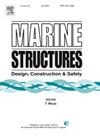基于BPNN和NSGA-III的聚脂系泊系统联合优化
IF 5.1
2区 工程技术
Q1 ENGINEERING, CIVIL
引用次数: 0
摘要
系泊系统的设计包括多个变量,如缆绳的跨度和数量、方向、分段、材料、配重、负载条件以及动态性能、结构安全性和经济成本等要求。传统的优化方法依赖于专业工具的广泛分析,通常在大规模计算和长时间后处理后效率低下。本研究提出了一种结合反向传播神经网络(BPNN)模型和非支配排序遗传算法III (NSGA-III)的代理辅助框架,用于聚酯系泊系统的优化。建立了考虑系泊系统设计共同要求的优化模型,并针对最大张力、平台位移和缆绳重量三个目标分别建立了独立的替代模型。然后,将NSGA-III与代理模型相结合,在可行样本空间内选择最佳组合。通过浮式生产单元(FPU)聚酯系泊系统的设计实例,验证了BPNN与NSGA-III联合优化的有效性。结果表明,该方法预测精度可靠,误差小于5%,比常规操作节省时间80%。结果表明,该框架为系泊系统优化提供了一种高效、准确的解决方案。本文章由计算机程序翻译,如有差异,请以英文原文为准。
A joint optimization by the combination of BPNN and NSGA-III for the polyester mooring system
The design of a mooring system includes multiple variables such as the line’s span and number, orientation, segmentation, materials, counterweights, load conditions, and the requirements like dynamic performance, structural safety, and economic costs. Traditional optimization methods, relying on extensive analysis with professional tools, usually performed inefficiently after large scale computation and long-time post processing. In this study, a surrogate-assisted framework combining Back Propagation Neural Network (BPNN) models and the Non-dominated Sorting Genetic Algorithm III (NSGA-III) is proposed to the optimization of polyester mooring systems. An optimization model considering the common requirements of mooring system design was established and three independent surrogate models were developed for each objective among maximum tension, platform displacement and cable lines’ weight. Then, the NSGA-III was integrated with the surrogate models to select excellent combinations within the feasible sample space. The joint optimization by the combination of BPNN and NSGA-III was validated through a design case of polyester mooring system for a Floating Production Unit (FPU). As a result, it showed reliable prediction accuracy with errors below 5 % and time saving with 80 % less than normal operations. The results show that the proposed framework offers an efficient and accurate solution for mooring system optimization.
求助全文
通过发布文献求助,成功后即可免费获取论文全文。
去求助
来源期刊

Marine Structures
工程技术-工程:海洋
CiteScore
8.70
自引率
7.70%
发文量
157
审稿时长
6.4 months
期刊介绍:
This journal aims to provide a medium for presentation and discussion of the latest developments in research, design, fabrication and in-service experience relating to marine structures, i.e., all structures of steel, concrete, light alloy or composite construction having an interface with the sea, including ships, fixed and mobile offshore platforms, submarine and submersibles, pipelines, subsea systems for shallow and deep ocean operations and coastal structures such as piers.
 求助内容:
求助内容: 应助结果提醒方式:
应助结果提醒方式:


